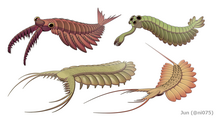Dinocaridida
| Dinocaridida Temporal range:
| |
|---|---|

| |
| Assembly of dinocaridids (Anomalocaris, Opabinia, Pambdelurion and Kerygmachela) | |
| Scientific classification | |
| Domain: | Eukaryota |
| Kingdom: | Animalia |
| Phylum: | Arthropoda |
| Class: | †Dinocaridida Collins, 1996 |
| Subgroups | |
Dinocaridida
Anatomy
Dinocaridids were
Classification
|
Dinocaridida |
Although some authors may rather suggest different taxonomic affinities (e.g. as
In the original description, Dinocaridida was composed of only Opabiniidae and Radiodonta.[1] With the exclusion of questionable taxa (e.g. the putative opabiniid Myoscolex[27]), the former were known only by Opabinia, while all radiodont species were grouped under a single family: Anomalocarididae (hence the previous common name 'Anomalocaridids'[18]). In later studies, the gilled lobopodians Pambdelurion and Kerygmachela were also regarded to be dinocaridids,[7] two new opabiniid genera, Utaurora and Mieridduryn were described,[28][29][30] other strange dinocaridids like Parvibellus (which might actually be a juvenile siberiid lobopodian),[31][29] many radiodonts were reassigned to other new families (Amplectobeluidae, Tamisiocarididae and Hurdiidae),[21] and a new family, Kerygmachelidae,[29] was named.
Distribution
The group was geographically widespread, and has been reported from Cambrian strata in Canada, United States, Greenland, China, Australia and Russia,[32] as well as the Ordovician of Morocco and Wales[2][33][30] and Devonian of Germany.[3]
Notes
- S2CID 83582128.
References
- ^ S2CID 131622496.
- ^ a b Van Roy, P.; Briggs, D. E. G. (2011). "A giant Ordovician anomalocaridid". Nature 473 (7348): 510–513. doi:10.1038/nature09920. edit
- ^ S2CID 47555807.
- ^ S2CID 85645934.
- ISSN 1001-6538.
- ISSN 1463-6395.
- ^ )
- ^ S2CID 7751936.
- ^ PMID 27989966.
- ^ S2CID 4451239.
- S2CID 226248177.
- ^ S2CID 250361698.
- ^ S2CID 205242881.
- PMID 16002096.
- PMID 24785191.
- PMID 29523785.
- ISSN 1103-5897.
- ^ S2CID 206517995.
- PMID 19854297.
- PMID 24077329.
- ^ S2CID 205237459.
- PMID 30218075.
- PMID 31362637.
- ^ PMID 31575373.
- .
- PMID 25959966.
- S2CID 131851540.
- PMID 35135344.
- ^ .
- ^ PMID 36379946.
- ISSN 2296-6463.
- S2CID 128957999.
- PMID 32742697.










